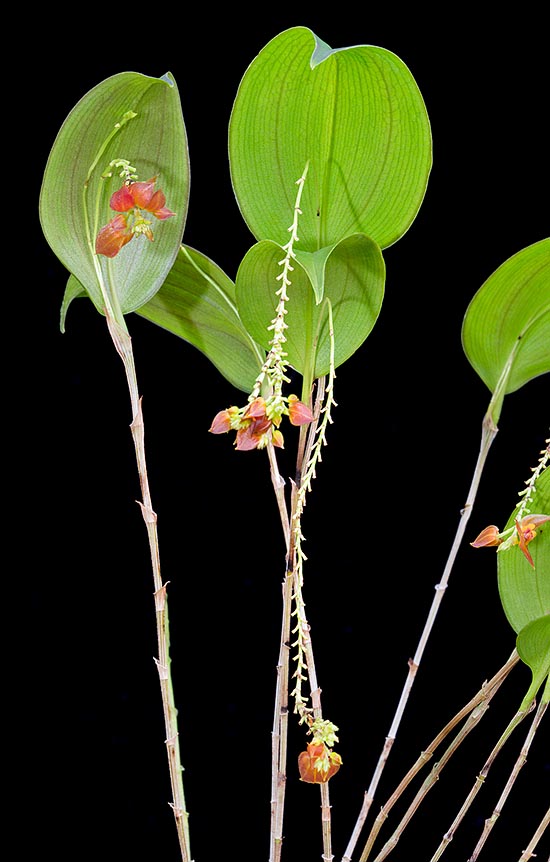Family : Orchidaceae

Text © Pietro Puccio

English translation by Mario Beltramini

Miniature orchid, Lepanthes cordeliae is an epiphyte of the mountain humid forests of Peru. Short rhizome and thin stems, of about 6 cm, with at the apex one ovate leaf with pointed 2,5 cm apex © Giuseppe Mazza
The etymology of the generic name has not been spcified by the author, after some is the combination of the Greek substantives “λεπίς” (lepis) = scale and “άνθος” (anthos) = flower, with reference to the shape of the flower of many species.
Others think it’s coming from “λέπος” (lepos) = bark and “άνθος” (anthos) = flower, seen that the plants of the genus live on the bark of the trees. The species is honoured to the discoverer, Mrs. Cordelia Head, J&L Orchids, Easton, Connecticut (USA).
The Lepanthes cordeliae Luer (1992) is an epiphytic cespitous species of reduced dimensions with short rhizome and thin stems, about 6 cm long, with at the apex an erect leaf of 2,5 cm with pointed apex and 1 cm broad, coriaceous, of intense green colour above, suffused of purple below.
Racemose inflorescences, on a 5-10 mm long peduncle, initially erect, then curved, with filiform rachis, up to 20 mm long, bearing numerous flowers opening gradually for long time with keeled sepals of purple red colour and reddish orange petals and labellum.
Elliptic dorsal sepal with pointed apex, 3 mm long and about2 mm broad, merged at the base with the latera sepals; elliptic lateral sepals with pointed apex, 2,7 mm long and 1,5 mm broad, united laterally at the base for about 1/3 of the length. Transversely and irregularly bilobed petals, 1 mm long and 2,5 mm broad, and bilaminate labellum 1,5 mm long.
It reproduces by seed, in vitro, and at amateurish level by division with each section provided of at least 3-4 stems.
Miniature orchid of easy cultivation, with blooming continuing for long time, requires a semi-shady exposition, intermediate temperatures, high ambient humidity and constant movement of the air.
Regular waterings and nebulizations utilizing rain water, demineralized or by reverse osmosis. It is usually cultivated in pots or baskets with draining and aerated compost formed by medium sliced fragments of bark and sphagnum. The repottings, when necessary, are to be done at the vegetative restart.

Racemose inflorescences, initially erect, then curved, with filiform rachis and several tiny flowers opening gradually for long time with purple red keeled sepals and reddish orange petals and labellum. Transversely and irregularly bilobed petals, 1 mm long and 2,5 mm broad, and bilaminate 1,5 mm labellum © Giuseppe Mazza
→ For general notions about ORCHIDACEAE please click here.
